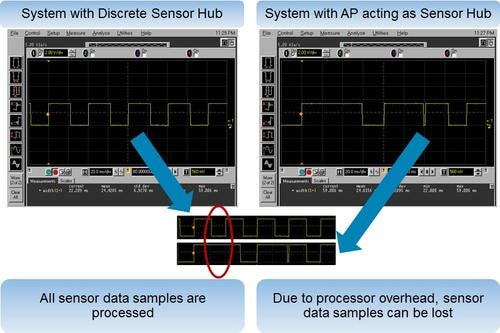The Pros & Cons to Sensor Hub & Sensor Sub-System Management
February 21, 2014

Today's leading-edge smartphones can contain more than a dozen unique physical sensors, often including an accelerometer, gyroscope, magnetometer, pressure, gesture, ambient light, and more. Used for applications from fitness to gaming, these sensors and their associated electronics are becoming one of the most important sub-systems within the phone.
Future high-end and mainstream smartphones are trending toward a state called "always-on context awareness." Always-on context awareness is a condition where all the various sensors in the phone are working in concert to allow the phone to understand the user's context. Context refers to the users' state -- walking, running, sitting, riding in a car/train/bus, sitting with the phone in front of them, etc.

This data is essential in a variety of emerging applications, including but not limited to:
Health and safety: Has the user fallen? Are they in a car, and if so, are they behind the wheel, and if so, should texting and web browsing capabilities be disabled?
Environmental monitoring and localized weather mapping
Indoor navigation and pedestrian dead reckoning: If the user is within a building, then what is their floor, location, and orientation?
Permission-based targeted advertising
For all the benefits these applications offer to the user, carrier, and OS, one thing they all have in common is the fact that sensors need to be operating. Users generally don't want to be hassled with having to remember to turn on and off specific sensors for specific tasks to happen, or for specific applications to work. Therefore, smartphone OEMs and application developers have requested that the sensor subsystem remain active at all times. To support all the desired context states, the sensor subsystem must also include sensors that support 9-axis, which includes an accelerometer, gyroscope, and magnetometer. This is the basis of always-on context awareness.
However, current implementations of sensor subsystems don't allow for practical always-on context awareness. The limiting factor is power consumption. OEMs have stated that always-on context awareness is only practical if the entire sensor subsystem power consumption is <2 percent of the battery capacity of the device. They believe that this level is an acceptable trade-off to the user between the benefits of context awareness and decreased battery life.
Additionally, OEMs and application developers have a strong desire for a sensor manager to be quickly and easily reconfigurable to allow different sensor management algorithms to be used both initially when the device is first purchased by the user, as well as "future-proofed" through software updates and application downloads.
Today's sensor management implementations are not able to achieve both the required power consumption and product flexibility requirements, however. Current sensor management hardware implementations include:
Application Processor (AP)-based Sensor Management
Microcontroller Unit (MCU)-based Sensor Hubs
Dedicated Application Specific Integrated Circuit (ASIC)-based Sensor Hubs
About the Author(s)
You May Also Like



.jpg?width=300&auto=webp&quality=80&disable=upscale)

